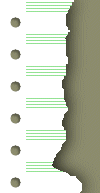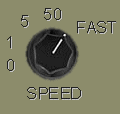ANELEX line printer
 The line printer used continuous stationery - the good old green-striped 15" wide stuff with sprocket holes down the side.
The line printer used continuous stationery - the good old green-striped 15" wide stuff with sprocket holes down the side.
For each of the 120 character positions across the line there was a spinning drum with all the character set around its circumference; a hammer for each position hit the paper against the ink-ribbon and through to the character typeface at just the right time to get the required character.
Layout was: 120 characters wide - 10 characters per inch horizontally, 6 rows per inch vertically.
There were of course NO lower-case letters, NO proportional spacing, NO choice of font/colour,
and NO bold or italic.
THERE WERE OF COURSE NO LOWER-CASE LETTERS, NO PROPORTIONAL SPACING,
NO CHOICE OF FONT/COLOUR, AND NO BOLD OR ITALIC.
The 64-strong character set consisted of the 26 capital letters, 13 numeric digits (yes 13! - there were single-character representations for 10, 11 and 12) and a small selection of punctuation, currency and control characters.
Vertical alignment was controlled by a Mylar tape loop (the Mylar was a distinctive metalic tape about 1.5" wide - pink on one side and silver on the other. There were central sprocket holes - one per line, so the standard loop would have 66 sprocket holes - 11" deep paper at 6 lines per inch. Special binary codes could then be punched at any point on the loop corresponding to a particular required printing location (say, address on an invoice); this code was used in the program's output instruction to indicate a jump to the required paper position. Top of page code was 387. 131 is another familiar code, but memory fades...

